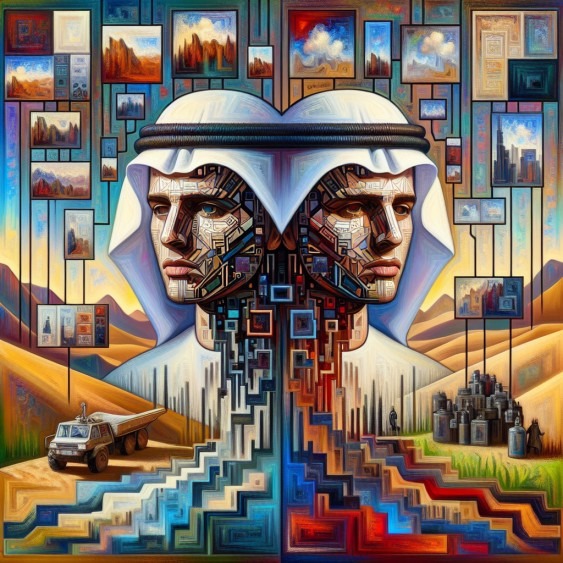
Real Doppelgangers: Today’s Deadly Threat
May 1, 2024
Introduction
In the ever-evolving landscape of artificial intelligence (AI), one phenomenon has captured the attention of researchers, security experts, and the general public: AI-based doppelgangers. These are highly realistic digital replicas of human beings, capable of mimicking their voices, facial expressions, and even their mannerisms with astonishing accuracy. Deepfakes, a term synonymous with this technology, are the product of advanced AI models that generate or manipulate audio and video content to create convincing forgeries.
The ability to create such replicas has opened up a Pandora’s box of potential risks and ethical dilemmas. While the technology is a remarkable achievement, its misuse poses significant threats to personal privacy, financial security, and even the integrity of democratic processes. The risks associated with these digital counterparts are increasingly pressing as AI advances, demanding immediate attention and action.
Understanding AI-Based Doppelgangers
At the heart of AI-based doppelgangers lies a class of AI models known as Generative Adversarial Networks (GANs). These models are trained on vast datasets of images, videos, and audio recordings, learning to recognize patterns and extract features that enable them to generate new, highly realistic content.
The process involves two competing neural networks: a generator and a discriminator. The generator creates synthetic data, such as images or videos, while the discriminator attempts to distinguish between the generated content and accurate data. Through this adversarial training process, the generator continuously improves its ability to produce more convincing and realistic outputs, eventually reaching a point where the discriminator can no longer reliably differentiate between the real and the fake.
This technology has evolved rapidly, progressing from basic voice-mimicking and face-swapping techniques to fully synthesized video doppelgangers that can mimic an individual’s entire range of expressions, movements, and speech patterns with uncanny accuracy.
Real-Life Incidences: Audio and Video Scams
The potential for misuse of AI-based doppelgangers has already manifested in several high-profile audio and video scams cases, resulting in significant financial losses and reputational damage.
Case Study 1: Voice Replication Scam
In 2019, the CEO of a UK-based energy firm fell victim to a voice replication scam that cost the company millions of dollars. The scammers used AI technology to mimic the voice of the CEO’s boss, instructing him to transfer funds to a supposed supplier. The CEO, convinced by the convincing audio, complied without suspicion, only realizing the deception after the funds had been transferred.
Case Study 2: Deepfake Video Scam
In 2020, a deepfake video purporting to show a prominent political figure making inflammatory remarks went viral, causing significant disruption and public outcry. While the video was eventually debunked, the damage had already been done, with the incident highlighting the potential for AI-generated content to manipulate public opinion and even influence elections.
These cases illustrate AI-based doppelganger scams’ emotional, financial, and societal consequences. Beyond the immediate losses, such incidents can erode trust in institutions, undermine the credibility of legitimate information sources, and contribute to the spread of misinformation and disinformation.
The Risks of AI-Based Doppelgangers
The risks associated with AI-based doppelgangers can be broadly categorized into three main areas: personal and financial security, social and political, and legal and ethical risks.
Personal and Financial Security Risks
1. Identity Theft Enhancements: Deepfake technology can create highly convincing impersonations of individuals, potentially enabling identity theft on an unprecedented scale. Biometric authentication systems, which rely on facial recognition or voice verification, could be compromised by AI-generated doppelgangers, granting unauthorized access to sensitive personal information or financial accounts.
2. Financial Frauds: AI-based doppelgangers can be employed in sophisticated financial scams, such as the earlier voice replication scams. Scammers can manipulate victims into transferring funds or revealing sensitive financial information by impersonating trusted individuals or authority figures.
Social and Political Risks
1. Misinformation and its Impact on Elections and Public Policies: The ability to create convincing deepfake videos and audio recordings opens the door to spreading misinformation and disinformation on a massive scale. Malicious actors could create fake content portraying political or public figures in compromising situations, potentially influencing elections or swaying public opinion on crucial policy decisions.
2. Manipulation of Media and Creation of False Narratives: AI-generated doppelgangers could fabricate entire news stories or create false narratives, eroding public trust in traditional media sources and contributing to the proliferation of “fake news.”
Legal and Ethical Risks
1. Inadequacy of Current Legal Frameworks: Existing legal frameworks may not be equipped to handle the challenges posed by AI-generated content. Issues surrounding consent, defamation, and intellectual property rights become increasingly complex when dealing with digital doppelgangers that can impersonate individuals without their knowledge or consent.
2. Ethical Dilemmas Involving Consent and Personal Likeness: The creation and dissemination of AI-based doppelgangers raise ethical questions about using an individual’s likeness without explicit consent. This technology can infringe on personal privacy and autonomy, blurring the lines between reality and fiction.
Preventative Measures and Legal Responses
Various preventative measures and legal responses are being explored and implemented in response to the growing risks posed by AI-based doppelgangers.
Technological Solutions
1. AI Detection Software: Researchers and tech companies are developing AI-based detection tools to identify deepfakes and other AI-generated content by analyzing subtle inconsistencies or artefacts that are difficult for the human eye to detect.
2. Blockchain for Verification: Blockchain technology is being explored to verify the authenticity of digital content. Storing and timestamping original media files on a decentralized ledger makes it possible to trace and verify the provenance of any content, making it more difficult for deepfakes to go undetected.
Legal Measures
1. Existing Laws and Proposed Regulations: While existing laws may not be specifically tailored to address AI-generated content, some legal frameworks, such as those related to fraud, defamation, and intellectual property, can be applied to some instances of deepfake misuse.
2. Proposed Regulations: Several countries and jurisdictions are exploring new regulations specifically targeting the creation and dissemination of deepfakes. These regulations aim to balance protecting individual rights and enabling legitimate uses of the technology.
Educational Initiatives
1. Raising Awareness: Government agencies, non-profit organizations, and tech companies are actively working to raise public awareness about the risks of AI-based doppelgangers and how to recognize and report potential scams or misinformation campaigns.
2. Media Literacy Programs: Educational programs focused on media literacy are being developed to equip individuals with the critical thinking skills needed to navigate the increasingly complex landscape of digital media, including the ability to identify and question the authenticity of AI-generated content.
Voices from the Industry: Expert Opinions and Forecasts
To gain a deeper understanding of AI-based doppelgangers’ challenges and potential solutions, we spoke with several experts from various fields, including cybersecurity, AI research, and legal advisory.
Cybersecurity Expert Jane Smith, CEO of CyberShield Inc.
“The rise of AI-based doppelgangers is a significant threat to cybersecurity and personal privacy. As these technologies become more advanced and accessible, we expect to see more sophisticated scams and identity theft attempts. We must stay ahead of the curve by developing robust detection and verification methods and implementing stricter regulations to discourage the misuse of this technology.”
Dr. Robert Johnson, AI Researcher at MIT
“While the potential for misuse of AI-based doppelgangers is concerning, we must also acknowledge this technology’s legitimate and beneficial applications. From entertainment and creative industries to medical and educational fields, the ability to generate realistic synthetic media could revolutionize how we create and consume content. The key is striking the right balance between enabling innovation and implementing safeguards to prevent malicious exploitation.”
Sarah Wilson, Legal Advisor at TechLaw Associates
“The legal landscape surrounding AI-generated content is evolving, and we’re playing catch-up in many ways. Existing laws may not adequately address the unique challenges posed by deepfakes and other AI-based doppelgangers. We must explore new legal frameworks that protect individual rights while fostering responsible innovation in this space.”
The Future Threat Landscape
As AI technology advances, the risks and potential threats posed by AI-based counterparts are expected to evolve and become more sophisticated. Several emerging technologies and advancements in AI could further refine or expand the capabilities of these digital duplicates.
Generative AI Models: While GANs have been the primary driving force behind deepfakes, new generative AI models like Diffusion Models and Large Language Models show promising results in generating highly realistic synthetic media. These models could create even more convincing doppelgangers, making detection increasingly challenging.
Multimodal AI: Current deepfake technologies primarily focus on manipulating audio or video. However, developing multimodal AI systems that seamlessly integrate and generate multiple modalities (audio, video, text) simultaneously could lead to even more realistic and convincing doppelgangers.
AI-Assisted Manipulation: As AI technologies become more accessible, malicious actors may leverage AI-assisted tools to manipulate existing media rather than generating entirely synthetic content. These tools could create highly targeted and personalized deepfakes, potentially increasing the effectiveness of scams and misinformation campaigns.
Deepfake Ecosystems: The emergence of online platforms and marketplaces dedicated to buying, selling, or sharing deepfakes and other AI-generated media could further facilitate the proliferation of these technologies, making them more accessible to individuals with malicious intent.
The arms race between creating and detecting AI fakes will intensify as these advancements unfold. Security systems and detection algorithms will need to continuously adapt and evolve to keep pace with the ever-improving capabilities of AI-based doppelgangers.
Conclusion
The rise of AI-based doppelgangers represents both a remarkable technological achievement and a significant challenge to personal privacy, financial security, and the integrity of information systems. The real-life incidents of audio and video scams highlighted in this article serve as a sobering reminder of the potential risks and consequences of misusing this technology.
While preventative measures, such as AI detection software, blockchain verification, and legal frameworks, are being explored and implemented, the rapidly evolving nature of AI technology demands ongoing vigilance and proactive action. As we navigate this new landscape, it is crucial to balance enabling innovation and ensuring the responsible development and use of AI.
Addressing the risks posed by AI-based replicas will require a multifaceted approach involving technological solutions, legal and regulatory measures, and educational initiatives. Collaboration between industry experts, policymakers, and the public is essential to foster a deeper understanding of the challenges and develop effective strategies to mitigate the potential threats.
Ultimately, the age of AI doppelgangers calls for a renewed commitment to ethical considerations in technology development. As we harness the power of AI to create ever more realistic digital replicas, we must also prioritize protecting individual rights, privacy, and the sanctity of truthful information.
By remaining vigilant, embracing responsible innovation, and fostering a culture of transparency and accountability, we can navigate the risks of AI-based doppelgangers while harnessing this technology’s transformative potential for the betterment of society.














